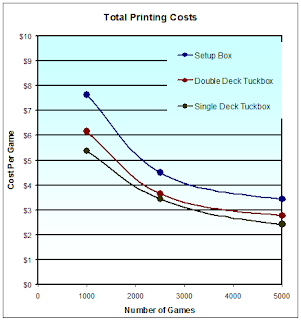I thought I'd compare the production prices for one of my printing bids to this model, where 1,000 games are wasted. What that means is if you're ordering 1,000 games, you're actually paying for 2,000, so your cost of production should be double what it actually is per game. If you order 2,000 games, you're paying for 3,000 copies, so your costs are 150% of the actual cost. The more you order, the more your cost drops, because the wasted games become less and less of the total produced, and their costs are pro-rated over the whole print run.
Sounds reasonable, right? Well, I thought I'd test it out to see what's going on. Here's an actual bid on my game from Imagigrafx. If you're interested, I discussed this in more detail in an earlier post here.
You can clearly see the drop in cost per game with increasing production runs.
I thought I'd try to model this statistically. The bid above tapers off to something near $2 per game. So, here's a hypothetical print run, for a game that costs $2 per game to print, but with 1,000 wasted games that also cost $2 per game. So, if you print 1000 and waste 1000, it will end up costing you 2,000 * $2 = $4,000. But, you only get 1,000 games, so that comes out to an apparent cost per game of $4.
This graph has the same shape as the real offer above, which makes sense. However, the values don't line up quite right - the drop off is steeper here, and you approach the $2 more quickly than in my real data.
So, this model doesn't quite work. I tried it out with 2,000 wasted games, and it was much closer (green line below):
So, is that's what's happening? 2,000 wasted games? Probably not, in reality. I'd guess there are a bunch of actual sunk costs to setting up a print run, and those are going to have to be paid regardless of the size of the run. So rather than wasting 2,000 games, it might be much fewer, and instead, the sunk costs (one-time setup costs) are making up the rest of the elevated apparent cost per game.
But as far as the statistics go, 2,000 wasted games seems to model the real bid I was getting pretty well, even if it's not exactly what's happening. Maybe this is a good rule of thumb in estimating the drop-off in printing costs for extended print runs? Seems like an easy enough model to use.


















They're not really "games" that are wasted, just paper and ink which are never assembled into games, but the economics of traditional printing are pretty awful for small runs. The only way to make sure all the colors align is to start the presses rolling, and you can't really tweak until everything gets up to full speed.
ReplyDeleteRight - they're not throwing shrink-wrapped product in the dumpster.
ReplyDeleteIs it color alignment that's the problem? I can see how that would be bad, to have the CMYK misaligned, but as for color mixing - I don't really care if my colors are off a bit if it would save some money.
I guess I'm just not familiar enough with the process to know exactly how it goes down.
You also have some fixed costs : shooting films for CMYK, setting up the press with the films/plates, color calibration, ...
ReplyDeleteSome of these costs are one-offs (if you make a reprint later on, they can reuse the same films/plates), other must be redone for each print run (lining up the plates on the printing press' rolls, mixing the colors, ...)
Another hidden cost is setting up the production line for your game (setting up the various trays of bits and worker posts along the production line : one guy places the meeples, another the dices, another the manual, another the boad, and so on.) Each production run means setting up the line for that specific game.
I do not realy think you can count the way you do here. With the fixed price of 2$ per game. The printing company do not have onley fixed expenses. If they had then you could count that way, I do not know the printingbuisnis enough to be able to say how big ther fixed- vs. there movingexpenses are. And without knowing that it is onley guessing... no?
ReplyDeleteI wasn't representing that this was accurate as to exactly what was going on, just that it fit the numbers well. I don't know what exactly makes up the fixed costs, although you guys have given some good examples. But assuming I'm making 'n' games, modeling it as some base cost applied to n+2000 games seems to fit the price drop I'm seeing from printers.
ReplyDeleteRemember how crappy color in newspapers used to be? It's easy to say you don't care, but..
ReplyDeleteTrue enough.
ReplyDelete